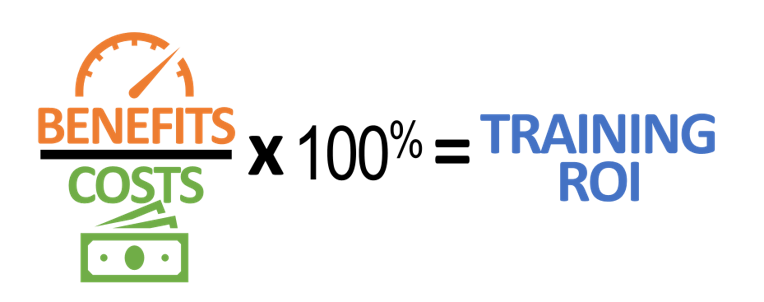
Learning and development professionals should be able to provide evidence of ROI value from L&D programs in order to get funding. Learning is the keystone for success, as it allows companies to attract new talent while developing current employees’ skillsets; which leads into increased productivity.
Most managers are seeking ways to extend product development time to use up more resources, to lose their best talent so that they can spend time and money to constantly be replacing them, and of course, to keep their internal costs as high as possible, right? Uh, no. In any business, regardless of size or complexity, the goal is to produce the product or service in a way that is sustainable and efficient. To achieve that goal, investments are made in corporate training to help employees gain the skills needed to get the job done. According to one industry report, companies invested $83 billion in corporate training in 2019, demonstrating the perceived value companies place on professional development.
But let’s focus on that word: value. How can managers know that the money invested in corporate training provides value? Return on Investment (“ROI”) impact studies and calculations are used to capture the outcomes, the value if you will, of training. Whether you are the training manager seeking a means to make the case for project management training to support the business, or you are the project manager requesting support for your own professional development, you should understand ROI and its role in corporate training funding.
On this page:

ROI 101
The international standard of ROI methodology and practice is grounded in Dr. Jack J. Phillips’ and Dr. Patti P. Phillips’ 25+ years of work and their ROI Institute, Inc. The white paper The ROI of Corporate Learning summarizes the Phillips’ ROI process model’s four stages: evaluation planning, data collection, data analysis, and reporting. Whether you seek full ROI certification or are just looking to understand the foundations, the core aspect of any ROI calculation is this: Benefits / Costs = ROI.

You need to make the case for corporate training to ensure employees have the skills needed to support the business. Data is key to your business case. The Phillips ROI Methodology sets out six data types you can use to measure training ROI:
- Reaction and Planned Action – Level 1
- Learning – Level 2
- Application and Implementation – Level 3
- Business Impact – Level 4
- Return on Investment – Level 5
- Intangibles
ROI for Training
When measuring ROI for training, you need to consider factors related to employee costs, vendor costs, and the business benefits. How benefits are defined (talent retention, increased sales, reduced time to market, or others) depends on the type of training you are measuring. The costs should include not merely the costs of training materials, but also consider the salary of the employees during training, any testing fees, or other associated expenditures.
When you take the approach of training as an investment, you can leverage ROI measurement techniques to bring to light the value of professional development. For example,
- A study by professional services company Accenture showed that forevery dollar invested in training, companies received $4.53 in return. That’s a 353% ROI.
- True Focus Media reports that companies utilizing e-learning tools “have the potential to boost productivity by 50%. For every $1 the company spends, it’s estimated they can receive $30 worth of productivity.”
Conducting ROI impact studies is a skill unto itself. But understanding the foundations of ROI will enable you to better:

ROI for Project Management Training
As Mark Bashrum points out in his article, Keep Your Training Program Funded: 10 Steps to Training ROI, “ROI is much more than a metric, it is a mindset.” And with the value-driven mindset, fueled by ROI thinking, your professionally trained Project Managers and Business Analysts can realize many benefits for the business.
Increased Efficiencies Lead to Decreased Project Timelines
Select your training topics to directly align with your business goals. Business skill classes such as
Leading Dispersed Teams, Time Management, Lean Six Sigma Green Belt, and Understanding Critical Path, enable project managers to better manage project work and realize efficiencies. You may be able to demonstrate learning ROI if the employees who complete specific classes are able to realize aligned business benefits.
Increased Management Skills Lead to Projects on Budget
The word “Manager” is part of the title of “Project Manager.” To that end, pursuing classes that are around fostering productive teams, such as Conflict Management, Emotional Intelligence, and Accelerated Team Building, can create consistently productive teams that complete work within set budgets. ROI tools may be able to capture that connection of training to business outcomes.
Corporate Training Support Leads to Talent Retention Savings
Clear Company’s most recent research found 68% of workers say training and development is the most important workplace policy. Further, 87% of millennials say professional development or career growth opportunities were very important. The investment in today’s employees can prevent the costs of finding replacements in the future.
ROI to Support Your Corporate Training Efforts
There are different ways to measure ROI value, just as there are different ways to conduct training. What is critical for any professional, as one pursuing one’s own professional development goals or as a manager seeking to develop others, are three key elements:
- training is viewed as a continuous process wherein employees learn and master the skills they need to grow in the job.
- Business value is a driver in the selection of training
- Training outcomes are measured in terms of business results
Use proven ROI methodology and tools as part of your ongoing training efforts. A business case driven by data is much for effective than one built on “those were great snacks in class today!” Your own professional brand can be enhanced when you use industry tools to demonstrate the return of investment for training.
Studying for the PMP Exam?
Upcoming PMP Certification Training – Live & Online Classes
| Name | Date | Place |


 New Horizons
New Horizons
 Project Management Academy
Project Management Academy
 Six Sigma Online
Six Sigma Online
 TCM Security
TCM Security
 TRACOM
TRACOM
 Velopi
Velopi
 Watermark Learning
Watermark Learning
 Login
Login




 New Horizons
New Horizons
 Project Management Academy
Project Management Academy
 Velopi
Velopi
 Six Sigma Online
Six Sigma Online
 TCM Security
TCM Security
 TRACOM
TRACOM
 Watermark Learning
Watermark Learning